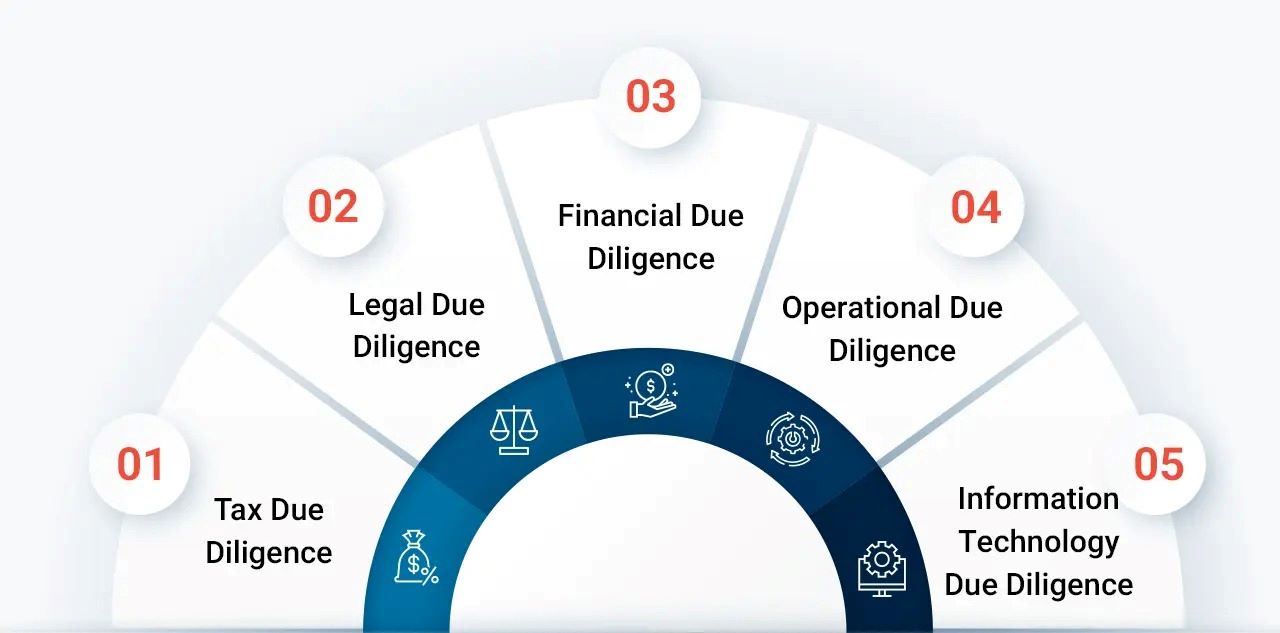Home>Finance>How To Do Due Diligence In Mergers And Acquisitions


Finance
How To Do Due Diligence In Mergers And Acquisitions
Published: February 24, 2024
Learn how to conduct effective due diligence in finance-related mergers and acquisitions. Understand the key steps and best practices to ensure a successful transaction.
(Many of the links in this article redirect to a specific reviewed product. Your purchase of these products through affiliate links helps to generate commission for LiveWell, at no extra cost. Learn more)
Table of Contents
Introduction
Mergers and acquisitions (M&A) are pivotal events for companies, often shaping their future growth and success. However, these transactions come with inherent risks, making it crucial for involved parties to conduct thorough due diligence. In the realm of finance, due diligence refers to the comprehensive assessment and investigation of a target company to evaluate its financial, operational, and legal aspects before finalizing an M&A deal.
This article serves as a guide to navigating the intricate process of due diligence in mergers and acquisitions. By understanding the essential steps involved and the significance of each stage, both buyers and sellers can effectively mitigate risks and make informed decisions, ultimately contributing to the success of the M&A transaction.
Throughout this article, we will delve into the intricacies of due diligence, from preparation to analysis, providing valuable insights and practical tips for optimizing this critical phase of M&A. Whether you're a seasoned financial professional or a business owner venturing into the M&A landscape for the first time, this comprehensive guide will equip you with the knowledge and strategies to execute due diligence effectively, ensuring a smoother and more successful M&A process.
Understanding Due Diligence
Due diligence in the context of mergers and acquisitions encompasses a meticulous examination of various facets of a target company. This process aims to uncover potential risks, liabilities, and opportunities, providing the acquiring party with a comprehensive understanding of the target’s financial health, operational efficiency, market positioning, and legal compliance. By gaining insights into these critical areas, the acquiring company can make well-informed decisions and mitigate potential pitfalls associated with the transaction.
Financial due diligence constitutes a fundamental aspect of the overall process, involving an in-depth analysis of the target company’s financial statements, cash flow, assets, liabilities, and financial performance over a specified period. This examination is crucial for assessing the target’s financial stability, identifying any irregularities or discrepancies, and projecting its future financial prospects within the context of the acquisition.
Operational due diligence delves into the operational aspects of the target company, encompassing its internal processes, supply chain management, technology infrastructure, and overall efficiency. By scrutinizing these operational components, the acquiring party can ascertain the target’s operational strengths and weaknesses, identifying potential areas for improvement or integration post-acquisition.
Legal due diligence involves a comprehensive review of the target company’s legal and compliance frameworks, contracts, intellectual property rights, and ongoing litigation. This aspect aims to uncover any legal risks, liabilities, or constraints that could impact the post-acquisition integration or expose the acquiring company to unforeseen legal challenges.
Furthermore, strategic due diligence focuses on evaluating the target company’s market positioning, competitive landscape, and growth potential within its industry. This analysis enables the acquiring party to assess the strategic fit of the target within its existing business operations and identify synergies that could drive value creation post-acquisition.
By comprehensively understanding the multifaceted nature of due diligence, both buyers and sellers can appreciate the depth of investigation required to facilitate a successful M&A transaction. In the subsequent sections, we will explore the preparatory steps, execution, and analysis of due diligence, providing actionable insights to optimize each stage of this critical process.
Preparing for Due Diligence
Effective preparation is paramount for conducting due diligence in mergers and acquisitions. Both the acquiring and target companies must meticulously organize and compile relevant documentation and information to facilitate a smooth and comprehensive due diligence process. This preparatory phase sets the foundation for the subsequent investigation, ensuring that all pertinent areas are thoroughly examined and evaluated.
First and foremost, the target company should assemble a due diligence data room, a centralized repository containing all essential documents and information that the acquiring party may require during the due diligence process. This data room typically includes financial statements, tax records, legal documents, contracts, intellectual property filings, organizational charts, and other critical information pertaining to the target’s operations and legal standing.
Simultaneously, the acquiring company should designate a proficient due diligence team comprising financial, legal, operational, and strategic experts. This interdisciplinary team is responsible for orchestrating the due diligence process, coordinating with the target company, and conducting a comprehensive examination of the provided documentation to assess the target’s viability and potential risks.
Furthermore, establishing a clear due diligence roadmap and timeline is essential for both parties. This roadmap outlines the specific areas and documents to be scrutinized, the key individuals to be involved in the process, and the projected timeline for completing each phase of due diligence. Clarity regarding the due diligence timeline enables both parties to align their efforts and resources efficiently, expediting the overall process and minimizing disruptions to the target company’s operations.
Moreover, fostering open communication between the acquiring and target companies is crucial during the preparatory phase. The target company should be transparent in providing access to the required information, while the acquiring company should communicate its due diligence objectives and expectations clearly. This transparent and collaborative approach fosters trust and facilitates a more streamlined due diligence process, ultimately benefiting both parties.
By meticulously preparing for due diligence, both the acquiring and target companies can lay the groundwork for a comprehensive and efficient examination of the target’s financial, operational, and legal landscape. In the subsequent sections, we will delve into the intricacies of executing and analyzing due diligence findings, providing actionable insights to optimize the overall M&A process.
Conducting Due Diligence
Once the preparatory phase is complete, the actual process of conducting due diligence in mergers and acquisitions commences. This stage involves a methodical and comprehensive examination of the target company’s financial, operational, and legal aspects, guided by the predefined roadmap and the expertise of the due diligence team.
The due diligence team from the acquiring company meticulously reviews the documents and information housed in the data room, analyzing financial statements, tax records, and operational metrics to gain a holistic view of the target’s current standing and future potential. This scrutiny involves identifying any discrepancies, irregularities, or red flags that may impact the viability of the M&A transaction or necessitate further investigation.
Simultaneously, the legal and compliance experts within the due diligence team scrutinize contracts, intellectual property filings, ongoing litigation, and regulatory compliance documentation to assess the target company’s legal standing and potential liabilities. This legal due diligence is critical for identifying any legal risks or constraints that could impede the successful integration of the target company post-acquisition.
Operational due diligence entails a close examination of the target company’s internal processes, supply chain management, technology infrastructure, and overall operational efficiency. This assessment aims to uncover any operational inefficiencies, dependencies, or risks that may impact the post-acquisition integration and the overall performance of the combined entity.
Throughout the due diligence process, open communication between the acquiring and target companies is essential. The target company should be prepared to address queries and provide clarifications promptly, facilitating a more efficient and focused examination. Additionally, the acquiring company’s due diligence team should maintain a collaborative and professional approach, ensuring that the process proceeds smoothly and respectfully.
By diligently conducting the due diligence process, both parties gain valuable insights into the target company’s financial, operational, and legal landscape, enabling them to make informed decisions and negotiate terms based on a comprehensive understanding of the target’s strengths and potential risks. In the subsequent section, we will delve into the critical phase of analyzing due diligence findings, shedding light on the pivotal steps involved in evaluating and interpreting the amassed information.
Analyzing Due Diligence Findings
Upon completing the due diligence process, the acquiring company’s due diligence team embarks on the critical phase of analyzing the amassed findings. This stage involves synthesizing the comprehensive array of financial, operational, and legal insights garnered during the examination of the target company, aiming to distill key takeaways and implications for the impending merger or acquisition.
Financial analysis forms a cornerstone of the post-due diligence phase, encompassing a meticulous review of the target company’s financial statements, cash flow projections, and historical performance metrics. This analysis enables the acquiring company to assess the target’s financial stability, growth trajectory, and the potential impact of the merger or acquisition on its overall financial position.
Operational insights derived from the due diligence findings are equally pivotal, offering a comprehensive understanding of the target company’s internal processes, supply chain dynamics, and technological infrastructure. By analyzing these operational aspects, the acquiring company can identify potential synergies, integration challenges, and opportunities for operational optimization post-acquisition.
Legal and compliance implications constitute another critical facet of the analysis phase. The acquiring company’s legal experts meticulously review the legal due diligence findings, assessing any identified risks, liabilities, or constraints that may impact the post-acquisition integration or expose the combined entity to legal challenges.
Furthermore, strategic analysis based on the due diligence findings enables the acquiring company to evaluate the strategic fit of the target within its existing business operations, assess market positioning, and identify potential growth opportunities and competitive advantages resulting from the merger or acquisition.
Effective communication and collaboration within the acquiring company’s due diligence team are essential during the analysis phase. By fostering interdisciplinary discussions and knowledge sharing, the team can collectively assess the implications of the due diligence findings and formulate informed recommendations for the subsequent stages of the M&A process.
Ultimately, the meticulous analysis of due diligence findings equips the acquiring company with a comprehensive understanding of the target company’s financial, operational, legal, and strategic landscape, empowering it to make informed decisions and negotiate terms that align with the identified opportunities and mitigate potential risks. In the subsequent section, we will conclude this comprehensive guide, encapsulating the significance of due diligence in mergers and acquisitions and its enduring impact on the success of these transformative business transactions.
Conclusion
The due diligence process in mergers and acquisitions represents a pivotal phase that underpins the success and sustainability of these transformative business transactions. By delving into the financial, operational, legal, and strategic facets of a target company, due diligence equips acquiring parties with invaluable insights to make informed decisions, negotiate terms, and navigate the post-acquisition integration effectively.
Throughout this comprehensive guide, we have explored the intricacies of due diligence, from its foundational principles to the meticulous execution and analysis of findings. We have underscored the critical role of preparation, emphasizing the need for both the acquiring and target companies to organize documentation, assemble proficient due diligence teams, and foster transparent communication to facilitate a comprehensive and efficient examination.
Conducting due diligence involves a methodical review of financial statements, operational processes, and legal frameworks, guided by a collaborative and respectful approach between the involved parties. This scrutiny enables the acquiring company to gain a holistic understanding of the target’s strengths, weaknesses, and potential synergies, setting the stage for informed decision-making and strategic planning.
Upon completing the due diligence process, the analysis phase synthesizes the amassed findings, offering a comprehensive evaluation of the target company’s financial stability, operational efficiency, legal standing, and strategic fit within the acquiring company’s business landscape. This analytical synthesis serves as the bedrock for formulating informed recommendations and negotiating terms that align with the identified opportunities and mitigate potential risks.
In essence, due diligence in mergers and acquisitions transcends a mere checklist of tasks; it embodies a strategic imperative that shapes the trajectory and outcomes of these transformative transactions. By embracing the principles and best practices outlined in this guide, both acquiring and target companies can navigate the due diligence process with confidence, leveraging it as a catalyst for informed decision-making and value creation in the dynamic landscape of mergers and acquisitions.
As the M&A landscape continues to evolve, the enduring significance of due diligence as a cornerstone of informed decision-making and risk mitigation remains unwavering, underscoring its indispensable role in shaping the future of businesses embarking on transformative growth journeys.














